Panasonic Viera TX-P42V10 42in Plasma TV Review
Panasonic Viera TX-P42V10 42in Plasma TV Review
Put simply, the Panasonic Viera TX-P42V10 is the best 42in plasma TV you can currently buy.
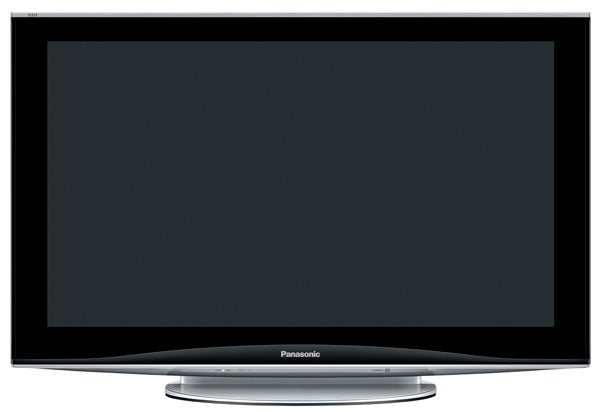
Verdict
Key Specifications
- Review Price: £1090.00
Regular readers will know that Panasonic has hardly been shy about sending us TVs to review this year. We’ve seen multiple sizes from nearly every part of the brand’s latest plasma and LCD range. The only one that’s slipped through the net is the V10 series. So we thought it was high time we put that right…
The V10 range is actually only the second model down in the latest Panasonic hierarchy, sitting below the flagship Z1 range we looked at a couple of months ago. But people rather daunted by the many thousands of pounds demanded by the Z1 models can take heart from the fact that the V10 is nowhere near as expensive. In fact, we’ve found the 42in P42V10 we’re looking at today going for under £1100 – a price that really looks a steal when you start investigating what the set has to offer.

For starters, in keeping with all the top half of Panasonic’s plasma range this year, the P42V10 sports a built-in Freesat tuner alongside the more typical Freeview and analogue tuner types. Also potentially hugely significant is the fact that it uses one of Panasonic’s NeoPDP plasma panels, which are able to deliver big advances in brightness and colour vibrancy versus Panasonic’s ‘normal’ plasma screens.
In practice, this means that the P42V10 gives you the flexibility to either watch pictures that are unusually dynamic by plasma standards, or else ramp down the brightness in return for substantial running power economies versus standard plasma models.
The P42V10 enjoys a Full HD 1,920 x 1,080 resolution, meanwhile – a key specification that’s still unique to Panasonic in the 42in plasma world. And as with all NeoPDP panels, it claims a contrast ratio of millions to one.
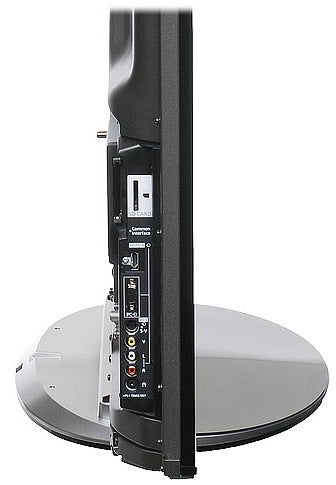
While we’re on the subject of big numbers, let’s also look at the P42V10’s 600Hz processing system. This number is obviously extremely high given that we’re only just getting to grips with 200Hz in the LCD TV world. And actually the 600Hz figure isn’t really describing a 600Hz cycle rate in the way you’d normally imagine. Rather it’s describing a situation where something called Sub-field Drive Intelligent Frame Creation Pro interpolates enough extra frames of freshly calculated image data to create a 600Hz-type effect. The reason for adding these extra frames is, of course, to dramatically reduce the motion judder problem that’s so associated with plasma technology – especially Panasonic plasma technology, funnily enough.
As you’d expect of a TV so near the top of Panasonic’s range, we’re nowhere near done with the feature finery yet. For alongside a healthy four HDMIs and a D-Sub PC port on the P42V10’s connections panel are an SD card slot that can play AVCHD and DivX video as well as JPEG sources, and an Ethernet port for hooking up to either a PC or the Internet.
Well, a bit of the Internet, anyway. For as with all ‘online TVs’ except for those from Philips, Panasonic currently only lets you access its own ring-fenced sites, containing content specially formatted for ease of access via a TV remote rather than a mouse and keyboard.
After a good 10 minutes updating the P42V10 (yes, people, having a TV capable of jacking into the Internet means you can now get to look forward to the ‘joy’ of regular firmware updates), I checked out the latest state of play for Panasonic’s Viera Cast system. And was reasonably happy with what I found.
The navigational interface remains attractive and straightforward, and the content level is solid, with Eurosport, YouTube, Picasa, and financial and weather reports all available. This is still short of what Samsung and Philips are offering with their online TVs, but it’s a decent start for this still relatively burgeoning feature.
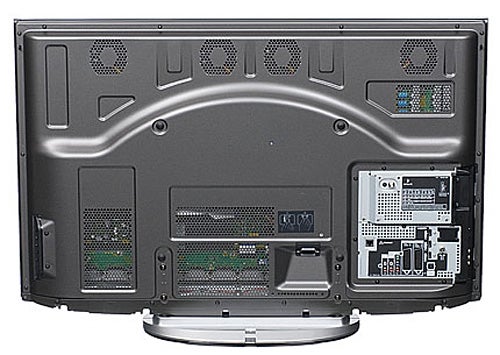
The last two ‘big’ features to report – in that they distinguish the P42V10 from models lower down the range – are Panasonic’s Digital Cinema Colour processing, and THX certification.
The former feature enables the P42V10 to reproduce the colour space established by Hollywood for use in digital cinema projection theatres, rather than the normal HDTV colour specifications. And THX certification means that as well as the TV having done enough with its performance to satisfy the THX analysts, the P42V10 carries a THX preset where the image settings have been set in-line with what THX believes to be the optimal levels for movie viewing. It’s interesting to note that with the THX mode engaged, the options for turning Intelligent Frame Creation and Picture Overscan on or off completely disappear from the TV’s menus.
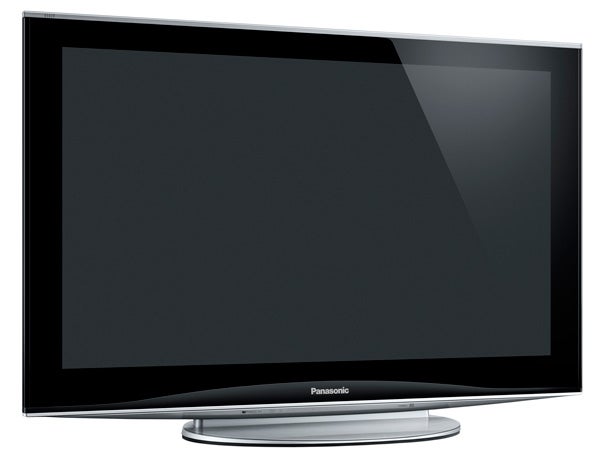
Before getting into the P42V10’s performance, I should pause for a moment to talk about the set’s design. For while it’s no jaw-dropping work of art, its ‘single sheet’ glass-like finish is rather posh, and the contrast between the black bezel and glossy silver desktop mount is appealing. The only catch with the glassy finish is that it shows up greasy finger marks like you wouldn’t believe. Just as well Panasonic ships a nice cleaning cloth with the TV!
As I’ve noted with other recent Panasonic TV reviews, plasma technology is no longer the dominant quality force over LCD that it once was. Some of the best LCD TVs out there for my money now outgun many plasma TVs in at least some picture areas. But even so, the P42V10 still does enough to warrant a best buy recommendation – especially given its relative affordability. The main reasons for this are that it scores strongly in what remain two key plasma advantage areas: motion clarity and black level.
Regarding motion, there’s no detectable response time-related motion blur whatsoever. Footballers charge about without losing resolution, cricket balls head off to the boundary without leaving smeary trails, camera’s pan across a scene without the whole picture softening up… To anyone seriously disturbed by the just-described motion problems associated with LCD, the P42V10’s almost instant response time will likely seem like a revelation.
It’s important to stress, too, that with the Intelligent Frame Creation system in play, the P42V10 doesn’t fall prey to plasma’s traditional judder issue nearly as badly as Panasonic’s 100Hz or even 400Hz models. The only time judder is an issue, in fact, is with the THX preset in play, which deactivates the IFC system. Clearly THX sees judder as a natural part of cinema viewing. But while I certainly understand and empathise with this ‘purist’ approach, there’s also no denying that the judder witnessed on the P42V10 without IFC engaged can sometimes get quite distracting.
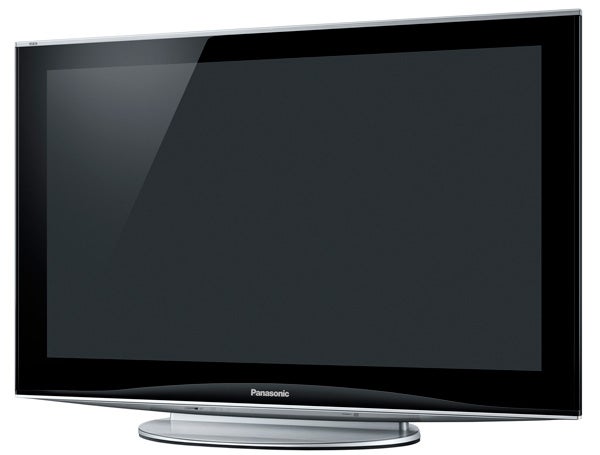
Turning to black levels, what makes them so great on the P42V10 isn’t so much their depth – though they certainly go deeper than all non-LED LCD TVs – as their naturalism. By which I mean that the deep blacks are achieved with no OTT reduction in brightness levels, a natural colour tone with no blue undercurrent, and lots and lots of lovely shadow detail helping give dark scenes a sense of depth and solidity most LCD TVs would sell their souls for. Especially as the black level depth doesn’t drop off if you have to watch the TV from an angle, as happens with practically every LCD TV in town.
The P42V10 can also deliver some terrific colour response with HD sources too, combining extremely natural tones with an exceptionally wide colour range.
Furthermore, the P42V10’s NeoPDP panel allows it to produce brightness levels much higher than most plasma TVs can muster. In fact, thanks to a combination of all the strengths just mentioned, the P42V10 can deliver HD movies that actually look cinematic. And you can’t ask for more than that.
Not that the P42V10 only likes HD, though. For Panasonic’s V-Real processing does a good job of upscaling standard definition to the P42V10’s Full HD resolution, sharpening images without emphasising any inherent signal noise.
Now for the bad news. Starting with the fact that while standard def pictures look sharp and clean, they don’t seem as natural or vibrant with their colours as HD ones. There’s also evidence during standard definition viewing of colour banding instead of perfectly smooth colour blends – a problem that very occasionally pops up with HD, too.
Next, even with the NeoPDP panel, and using the TV’s really quite ugly Dynamic picture preset, the P42V10’s pictures aren’t as bright and dynamic as those of a good LCD set. And this brightness difference becomes more pronounced using one of the set’s more sensible presets, such as Cinema or THX. In a darkened room I guess this might not be too much of a problem, but it does stop images having that ‘pop’ that so many people like to see.
Next, while HD pictures look detailed and extremely natural, they don’t look quite as pin-sharp as we’ve seen them on one or two LCD TVs.
Finally, the IFC processing does cause some gentle artefacting from time to time, in the form of some slight shimmering around moving objects, sporadic flickering, and even a touch of shearing under extreme circumstances.
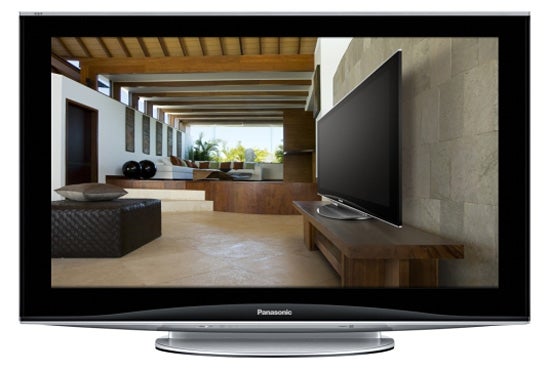
But such issues are common with pretty much every strong motion-processing system to some extent, and in the great scheme of things the P42V10’s artefacts aren’t severe enough to stop the system being a major benefit to pictures for 90 per cent of the time. Plus, of course, when the feature does become distracting with certain high-octane sources, well, you can just turn it off!
Turning to the P42V10’s audio, it isn’t as all-round excellent as its HD pictures. Chiefly because a slight shortage or range at both the bass and treble ends of the audio spectrum leaves the mid-range feeling a bit compressed. Good volumes can be achieved without distortion or cabinet ‘hum’ setting in, though, and the set has a decent stab at opening up to accommodate action scenes.
Verdict
I guess a couple of big comparison questions need to be cleared up here. So first, is the P42V10 a Pioneer ‘KURO’ killer? No, it isn’t. The latest KURO plasmas still outgun the P42V10 on black levels and colour response – though of course, they cost considerably more.
How does the P42V10 stack up against the best LCDs? Here it’s more complicated, and a sort of ‘horses for courses’ situation. For while the best LCDs produce punchier, sharper, more dynamic images with less colour banding, the Panasonic scores on black level (except for more expensive LED backlit TVs) and motion clarity/response time.
Hmm. All this compare and contrast stuff is starting to sound unfairly negative. So probably the best way I can sum the P42V10 in a more upbeat context is by saying that it is actually the best 42in plasma TV you can currently buy (given that Pioneer doesn’t do 42in ones anymore). Which makes it a must-audition set for anyone unsure as to which TV technology to buy, and an absolute no-brainer for LCD haters. Especially given its surprisingly aggressive price.
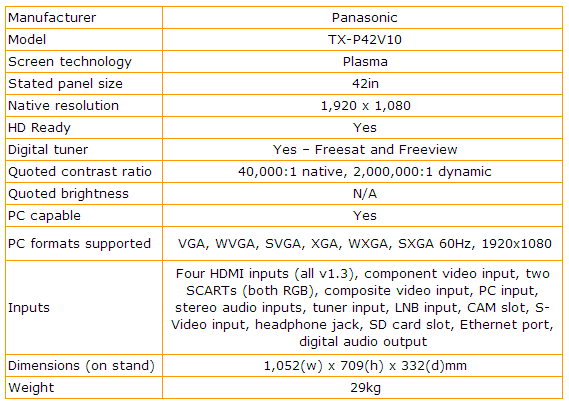
How we test televisions
We test every TV we review thoroughly over an extended period of time. We use industry standard tests to compare features properly. We’ll always tell you what we find. We never, ever, accept money to review a product.
Trusted Score
Score in detail
-
Features 9
-
Value 9
-
Image Quality 9
-
Design 8
-
Sound Quality 8
Features
| Size (Inch) | 42in |
| Display Type | Plasma |

